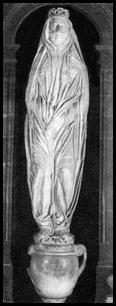  |
 |
 |
 |
 |
| Fri 09 May 2025 |

The History Of All Saints' WickhambrookNicholas Stone
John Donne Nicholas Stone (1586-1647): Greatest sculptor of his century, he was born the son of a quarryman in Devon, but soon moved to London, then to Holland, to gain greater experience. In Holland he apprenticed himself to Hendrik de Keyser, a famous master mason. The story has it that one piece of work he carried out so delighted his master that Stone was given the hand of de Keyser's daughter in marriage. He worked for de Keyser from 1607 to 1613. By 1614, Stone was back in London as mason and statuary; and quickly gained such a reputation that he was employed by the king on the royal palaces and on great buildings in London. Only five years after his return from Holland, he was made master mason to James I in 1619, and in 1626 Charles I confirmed him in that appointment. His earliest work in Suffolk is at Hawstead and there are other fines pieces at Ampton, Redgrave, Hessett and Wickhambrook. He worked on the Banqueting House, Whitehall, where he began an association with Inigo Jones. He is best known for his tombs, which include that of Francis Holles (Westminster Abbey) based on Michelangelo's tomb of Giuliano de Medici, and that to John Donne (made from Donne's own design, St Paul's Cathedral). There was a decline of English sculpture after Mid-Gothic times. It is not until Nicholas Stone that something approaching real sculptural quality returns. His monument to the great poet John Donne in St Paul's Cathedral shows imagination and vivacity in handling of the overall composition. The civil war delivered a devastating blow to the work of Nicholas Stone and the building industry in general, as Parliamentary forces inflicted great damage to many churches up and down the country, and cathedral libraries were looted and ransacked. It is perhaps an irony of history that Stone's Banqueting House ended up as the venue for the execution of his beloved King Charles. Virtually nothing is known of the rest of Stone's life and he passed away on the 24th August at his residence in Long Acre, aged 61, and was laid to rest in the parish church of St. Martin-in-the-Fields. Stone left a substantial estate which included five houses together with the workshop in Long Acre, and was described in his will as 'Esquier', having earned well in excess of £11,000, a sum few of his contemporaries could match. His youngest son John, also a freemason, took over the family business, having been originally intended for the church, and educated at Westminster School and Oxford University. When he died in 1667, his foreman sculptor took over the reins of the business and went on to carve the phoenix over the door of St. Paul's Cathedral. A more detailed account of the life of Nicholas Stone can be found on Wikipedia. |

